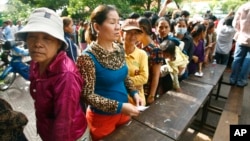Parliamentary seat allocations do not reflect the balance of votes cast and migration the country has experienced in the last decade, an analyst has said.
Ou Virak, president and founder of the policy think tank Future Forum, said there should be a review and more transparency in the seat allocation process.
Some areas of the country have seen high fluctuations in population due to migration, births and deaths in the past decade, he said, but their political representation remains unchanged.
He pointed out that Phnom Penh had grown by 80% since 1998, but still only had 12 seats in parliament, compared with Prey Veng province, where the population is below Phnom Penh’s 1998 level of about 1 million people, but has 11 seats.
“This means that each vote cast in the Phnom Penh capital is half the value of a vote cast by their fellow voters in Prey Veng province,” Virak told the Hello VOA program on Monday. “Therefore, voters in Prey Veng have more weight in parliament than those in Phnom Penh. This is an imbalance and injustice for the Phnom Penh dwellers.”
The Future Forum released a paper in January suggesting that Phnom Penh should have 15 seats and Prey Veng should be reduced to 8, while Battambang and Siem Reap provinces should be increased from 8 to 10, and 6 to 9, respectively.
Cambodia’s parliament has 123 seats, a figure that will increase to 125 following the 2018 elections, according to a political deal between the ruling Cambodian People’s Party and the opposition Cambodia National Rescue Party in 2014.
The deal has given two additional seats to the coastal province of Preah Sihanouk.
“Sihanoukville should not be given three seats,” Virak said. “The agreement between the two parties gave two additional seats to Preah Sihanouk without any concrete reason or formula. They simply thought of something and made a suggestion to each other to added two more seats. In reality, there should be only one additional seat.”
If the 1997 election law is applied properly, Cambodia should have up to 139 parliamentary seats, Virak said.
Virak said the increase would see more parties winning seats in parliament and would likely not be a strain on public resources.
“Interestingly, if the parliamentary seats increase to 139, I see that there will be more smaller political parties being elected to the parliament,” he said. “This is a formula to enable a multi-party chamber. It is a good formula for smaller political groups.”







